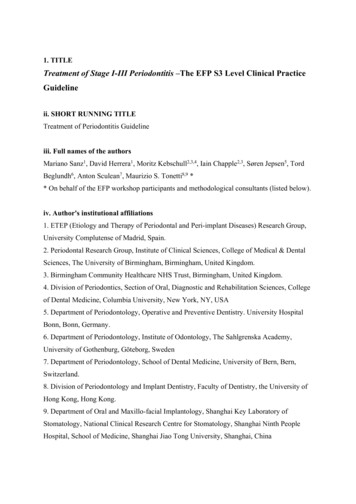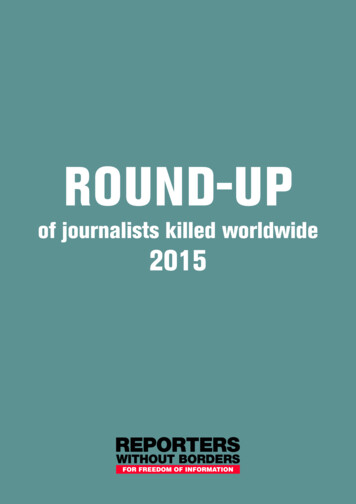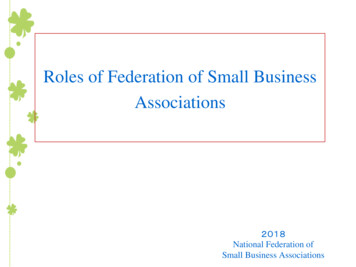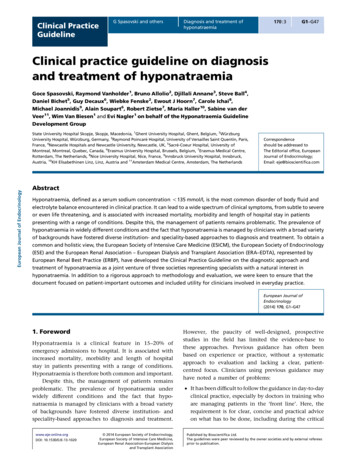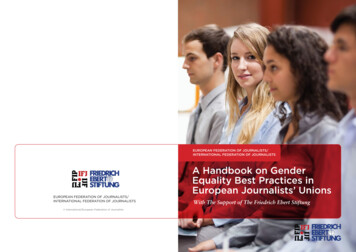
Transcription
EUROPEAN FEDERATION OF JOURNALISTS/INTERNATIONAL FEDERATION OF JOURNALISTSEUROPEAN FEDERATION OF JOURNALISTS/INTERNATIONAL FEDERATION OF JOURNALISTS International/European Federation of JournalistsA Handbook on GenderEquality Best Practices inEuropean Journalists’ UnionsWith The Support of The Friedrich Ebert Stiftung
Foreword4Best practices in European Journalists' Unions:Increasing Participation6Best Practices in European Journalists' Unions:Impacting the Workplace14Best Practices Adopted by Media Organisations24Annexes32Appendix37Publisher information: International/ European Federation ofJournalists, Résidence Palace, rue de la loi 155, 1040 Brussels, BelgiumCopyright: No part of this publication may be reproduced in any formwithout the written permission of the publisher. The contents of thispublication are copyrighted and the rights to use of contributions restwith the authors themselves. All rights reservedISBN: The author is responsible for the choice and presentation of thefacts contained in this book and for the opinions expressed, which arenot necessarily those of FES and do not commit the organisation. Thedesignations employed and the presentation of material throughoutthe publication do not imply the expression of any opinion whatsoeveron the part of FES concerning the legal status of any country, territory,city or area or of its authorities, or concerning the delimitation of itsfrontiers or boundaries.Author: Kerstin KlamrothEditors: Mindy Ran, Pamela MorinièreDesign: Emily J Fischer www.emilyjfischer.comPrinted by: PLAN2000 INCPublished in: International/European Federation of Journalists43A Handbook on Gender Equality Best Practices in European Journalists’ UnionscontentsCONTENTS
GENDER MAINSTREAMING IS:“ the process of assessing the implications for womenand men of any planned action, including legislation,policies or programmes, in all areas and at all levels. Itis a strategy for making women’s as well as men’s concernsand experiences an integral dimension of the design,implementation, monitoring and evaluation of policiesand programmes in all political, economic and societalspheres so that women and men benefit equally andinequality is not perpetuated.” 1“Gender mainstreaming in all areas and at all levels.” This quotation highlights the difficulties, complexities and wide ranging scope encountered in providingan overview of actions reported as being the most significant, impacting on gender equality, by national socialpartners. After the Beijing Declaration was adopted atthe United Nations Fourth World Conference on Womenin 1995, the potential of the media to make a greatercontribution to the advancement of women was recognised, and special recommendations on how to achieveequality targets soon followed. As a result, many journalists unions included gender equality as a regular feature of their agenda and working programme.women and youth in trade unions. It is hoped to engagewith more unions through this conference, and to eventually add their voice and practice to this handbook.This handbook is based on a survey, completed throughextensive communications with journalist trade unionofficials responsible for gender issues, throughout theaffiliated unions of the European Federation of Journalists (EFJ) (a section of the International Federation ofJournalists (IFJ)). Sadly, it is not yet completely representative of the region, as many unions in the east andsouth did not respond. Also, there were situations wherecontact people or information was simply not available.Journalists unions promote gender equality in differentways, using their influence in economic and social negotiations, such as collective bargaining. In their ownorganisations, they offer a platform for networking andmentoring. Another important aspect for media unionsare the guidelines developed and offered to encouragemore sensitive use of language, and to avoid stereotypical representation and portrayal of women and men,in the news. The media, as a collective whole, is a keyinstitution in the fight to achieve women’s equality andhuman rights in society and has a huge responsibility toinform debate, to educate and to present the world in afair, unbiased and ethical manner.Recognising this lack of contribution may also be asignificant sign that these areas needed more support,the EFJ Regional Gender Conference of 2012, AthensGreece, will focus on empowering more participation of4In the meantime, those that did respond confirm a growing sense of the value of gender equality in journalismwithin European nations, over the last two decades.However, the survey also shows that there is still a lot ofwork to be done in order to achieve a true, balanced gender reality within European media. For example, youngwomen may be highly visible on television, but are stilla minority in other areas of “serious” media, such aspolitics or economics.We hope that this work will also be seen as encouragement to unions not to forget this issue, even if times aredifficult and lean management is necessary. Sharing information on best practice is one way to support womenwithin the national unions, and is the goal of this handbook.1. The Report of the Economic and Social Council for 1997,These differences, from nation to nation and region toregion, were mirrored in the various ways that affiliatesresponded to the request to participate in this survey.Whereas some unions are well organised and have assigned gender officers, others are not so well equipped.United Nations, 1997At the same time, many unions are implementing diversity and equality programmes, some for the first time.There are collective agreements on parental leave andpart-timework, guidelines, mentoring programmes,training courses, surveys, congresses, actions plans,events and campaigns. While some of them are stilldiscussing their options, others already have startedimplementing projects. In particular, journalist unionsin Scandinavia stand out as successfully tackling genderissues. For this reason, their projects are among thosehighlighted extensively in this handbook.In many cases, it is the unions themselves that have initiated good practice examples by increasing the rate ofrepresentation of women in leadership positions, discussing quota systems, offering negotiation, and otherforms of training and encouraging women, in order tostrengthen their role in the unions. Most of the unionshave established committees, or gender/equality councils, to provide statistics on wages and working conditions for women in the field, as well as offer support andguidelines.Sometimes, as will be shown in the handbook, a smallgesture can have a large impact, for example: In Sweden and the UK, the journalists unions reimburses childcare costs, or run a crèche for events, to enable femalemembers to participate fully in the organisation. Theyalso recommend an awareness of the impact that timing,agenda and duration of meetings can have on women’s5forewordfamily responsibilities. The survey showed that the suggested changes need not always be huge, but women willbe more attracted to membership and participation ifthey see that unions address their issues, and representthem more effectively.Our intention is not to give an exhaustive list of all theactions undertaken, but to highlight some examples ofbest practice initiatives, so that other unions can shareand use this knowledge to inform their own decisionswhen developing gender equality policy.A Handbook on Gender Equality Best Practices in European Journalists’ UnionsforewordA Handbook on Gender Equality Best Practices in European Journalists’ UnionsFOREWORDUnions, as employment rights organisations, also aresubjected to the same market forces as any other societal group and therefore must also face new economicchallenges and new developments within labour norms.These days, they are no longer able to only fight for employment, equal pay, health issues or pensions. Labourorganisations from Malta to Norway, and from Russiato Italy, must now also focus on the reconciliation ofwork and family life, anti-bullying and harassment issues and on the balance of women in decision makingroles, as this is the only way to achieve a balanced participation of men and women in the professional arena.However, they also have to have an awareness of varyingconditions in accordance with national needs and on thebasis of national legislation. As a result, to be effective,unions need to use a variety of tools and means to address gender equality at national, regional and companylevels.
Increasing ParticipationA Handbook on Gender Equality Best Practices in European Journalists’ UnionsGENDER EQUALITY BESTPRACTICE IN EUROPEANJOURNALISTS UNIONS:Increasing Participation12Gender monitoringTo measure progress towards gender equality, regularmonitoring needs to take place to evaluate progress andplan further action. Results of this monitoring must bewidely shared. For everyone to be fully involved, theyneed to understandwhere progress is lagging, whereprogress is moving forward and the targets.Best practice example:Setting up a Gender Equality AgendaThe Swedish Union of Journalists Action Programme:Some unions, particularly in Scandinavia, do not include specific gender programmes, as they believe thateither gender equality has been achieved, or has beenenshrined in law. Other unions believe that there is still alot of work to do, as laws must be implemented to work,and plan their work very carefully, step by step. Actionplans and guidelines are a good means to build up a successful strategy, even under the impact of the economiccrisis, when action on gender equality is under pressure.In the current economic and social crisis, there is a riskthat gender equality policies are neglected, as they areseen as ‘side-issues’. Tackling the crisis has often beenelevated to the top of the policy agenda of unions, whileforgetting that the principle of all trade unionism is justice and equality for all members.Do not allow unions toforget this principle.Best practice example:The Finnish Union of Journalists (UJF), Suomen Journalistiliitto (www.journalistiliitto.fi), adopted its GenderEquality Action Plan during a general meeting in 1994.The plan demands, for example, that boards are composed in a balanced way, gender awareness training willbe offered, and declares the intention to foster researchon gender issues. Such a declaration involves all members of the union, and provides a common base for eachmember to relate to the policy and its goals. The UJFequality work is still based on this Gender Equality Action Plan. As part of the action plan, the union board hasalso established a specific committee to plan and discussequality matters. This committee collects gender-basedstatistics on union members, management, shop stewards and staff. As a result, the union maintains up todate information on it’s own structure.(See Annex for full details of the plan.)The Union should provide an example of focused worktowards equality. One of the roads to this goal is thateach section, on every level, annually evaluates theimpact of its promotion of gender equality and workagainst discrimination. For the evaluation not to remainonly a good intention, but to become a part of a regular routine, the National Executive can send out a callonce a year to clubs, divisions and districts, or declare aweek every year an “equality week” in order to compileand publish the results. “There is still much work to bedone that requires the active involvement of all levelsof the union before we have made a clean sweep of ourconscious and unconscious prejudices against people because of their gender, age, physical or mental conditions,ethnic and cultural backgrounds, or sexual orientation.The union should also actively promote gender balanceamong elected officials, train members in awareness ofgender issues and discrimination, provide statistics onwages and working conditions, and monitor, supportand provide research on gender equality and genderroles. The national office provides local branches withpractical tools to enable them to do this work: guidesto achieve gender equality step-by-step, guides on howto produce useful local wage statistics, and examples ofhow a concrete equality action plan can be designed.The union should also initiate a discussion about marketforces versus equality, in the collective bargaining process, as well as in local wage negotiations and public debate. Has discrimination occurred due to market forces,then a plan should be drawn up to correct the imbalance.The union should also initiate research on market forces’impact on wages and working conditions, from a discrimination perspective.Authorities and public institutions, such as the EqualOpportunities Ombudsman, Ombudsman against Discrimination, and the Labour Market Mediation Institute, all have specific mandates from the Parliament inregard to promoting equality between women and men.The union should confront these organisations with anyconflicts the market may generate in terms of gender inequality and insist on measures to counteract any discrimination discovered.Additionally, it must be possible to combine both professional work and union work with parenthood. Theintentions of the legislation on equal opportunities mustbe respected in both national and local negotiations. Theunion reimburses additional costs for childcare when theneed arises due to union work at national level.During collective bargaining, discriminatory salariesshould be corrected, in addition to regular local wagenegotiations. This approach should also be spreadamong other unions.The regional branches have a coordinating role interms of regional exchange of experience between localbranches and workplaces, but also provide a forum fordebate and advocacy.Preparations for changing anti-discrimination laws arein progress, and new legislation is expected. When/if thisoccurs, the National Executive will explore the possibilityof organising specific information meetings addressedinitially at local negotiators.Employers and local union branches have a joint responsibility to correct the discriminatory effects of marketforces, by using the tools provided by labour legislationand common sense.Contact: Tytti OrasEmail: tytti.oras@journalistiliitto.fi6Contact: Svenska Journalistförbundet, POBox 1116,11181 SwedenEmail: anita.vahlberg@sjf.se7
Adopting positive discriminationmeasuresQuotasTo increase women’s participation and representationmany journalists unions have developed various strategies. One of them is a quota system. This aims to ensurethat women constitute at least a minimum of 30 - 40percent of decision making bodies, often related to theirproportion in the trade union’s membership. Quotas forwomen ensure that women constitute a certain numberof the members of a body, whether it is a candidate listor a committee. The quota system places the burden ofrecruitment, not on the individual woman, but on thosewho control the recruitment process.With the presence of women on boards, discussions tendto address a wider set of stakeholders. The leadershipstyle tends to be more collaborative, improving communication within the board, and with management. Forchanges to occur, experience shows that a critical massof three women on a board is necessary, as this has beenfound to be the minimum number required to ensurethat women’s voices are heard in discussions. There arestill many arguments against quotas. One common complaint often heard is that there are not enough women tofill the seats mandated. However, a lot of women thinkthat the real problem is one of recruitment, as men tendto recruit from their own, male-based networks.Best practice example:Verdi, one of the German unions of journalists, decidedthat all actors within the organisation should be takeninto account to realise the equal participation and representation of women and men. Since 2007, the unionimplemented a women’s quota, which means that half ofall executive posts are occupied by women.The number of women on boards and committees holding union office should, at the very least, correspond tothe percentage of female members (proportionality). Thisis what the union’s rules stipulate (§ 20 Principles §3 and§ 83). Quota for women represent 50.44 percent of totalmembership; therefore they fill half the posts on boardsand committees. On the elected Executive Committeesof 11 regional districts, women hold two of the threemandates. Even on the main board, the Bundesvorstand,women occupy nine of fourteen seats. As a result, ver.diis the only union in Germany that implements a consistent quota for both voluntary and paid managerial staff.Developmentof the membership Numbers PercentageWomenIn Germany (26 February, 2012), hundreds of top femalejournalists demanded the introduction of a quota systemto ensure that women fill at least 30% of all executivepositions, across the German media industry, over thenext five years (Contact: http://www.pro-quote.de).They sent a letter to editors and publishers and launcheda campaign called “Pro Quote”. The letter described thepresent situation where only 2% of all editor-in-chiefsof 360 German daily and weekly newspapers are women, and just three of the 12 bosses of the public servicebroadcasters are female. “Without a quota, clearly nothing will change”, said Anne Will, famous political chatshow host. Pro Quote found that more than 3500 Data from January, 20124Increasing Participationporters signed the petition on the website. The weeklynewspaper “Die Zeit”, and the magazine “Der Spiegel”have now both announced their intention to fill moreleading positions with women.Developing gender and/or equalitycouncilsBeyond the representation of women at the executivelevel, a lot of journalists unions have special platformsfor women – as well as for other groups often targetedfor discrimination, such as migrant workers, minorityand ethnic members, disabled workers, or the unemployed. These platforms offer a forum for debate, andfor the development of ideas. Gender equality requiresthe commitment of both men and women, as both willbe impacted, and it is therefore essential that men alsoparticipate in the councils. They also have to recognisethe importance of equal rights and equal representation.Acting jointly is important.Best practice example:In many unions, gender or equality councils are responsible for equality action plans. They insist on transparent budgets for gender initiatives, implement trainingprogrammes to prepare women for leadership positions,collect statistics on male and female membership, andon the representation of women and men in decisionmaking bodies. They also administer special budgets andlogistical support. In many cases, they also carry out research into the working conditions of women, and organise gender-audits.The National Union of Journalists, UK and Ireland(NUJ), has a long history of promoting equality, but thisdoes not mean that it is immune from the problems associated with encouraging more women to become active in the union. The NUJ has had rules on equality formany years, and has Equality Council to promote genderequality. This council is nominated and elected directlyby the membership via nominations from local branches, with the election being held at the union’s DelegateMeeting (every 2 years).Every two years, around International Women’s Day(8March), the German union “DJV” organises a congress “Frau Macht Medien” (Woman makes the news)with panel discussions and workshops on empowermentfor female members.The NUJ also requires branches and chapels to elect anequality officer who is responsible for promoting equality within branches and workplaces and ensuring equalityissues are always on the agenda. This reflects the union’sattitude that equality, including gender equality, shouldbe mainstreamed throughout the union’s work.Potential actions for Gender Councils: Pool for gender resource materials Gender equality week Hotline for women to lodge complaints Data bank with female experts for panel discussions,and for use in newsrooms and as interview sources Data bank for female trainers Project evaluation teams that assess whether theunion’s policy had improved the situation of women Training programmes to empower women membersActions for International Women’s day (March), WorldPress Freedom Day (May), and the Human Rights Day(December).This data has yet to be evaluated for impactand potential influence on the union’s policy.Contact:www.verdi.de/frauen/frauen verdi/frauenquote– EU-Vice-President Viviane Reding announced the quotaat the gender council of the German journalists union DJV.Photo: Silke Schneider-Flaig.In 2009, the NUJ’s Equality Council took a motion tothe Delegate Meeting demanding that the union beginto tackle the issue of under-representation of women atbranch, council and national executive council levels ofthe union. In recent years, the union has recruited morewomen than men and it had a large proportion of women workplace representatives. Many are the leaders oftheir chapels and others take positions such as EqualityOfficer and Union Learning Rep. Following a workplacesurvey carried out by the union approximately four yearsago, it was clear that there is no problem with the levelsof women’s activity in workplaces. Women take leadership positions, which require a high level of commitmentand courage, as these often bring them into conflict withemployers, and are enthusiastic about getting active intheir workplace.Contact : Lena CalvertEmail: LenaC@nuj.org.uk9A Handbook on Gender Equality Best Practices in European Journalists’ UnionsIncreasing ParticipationA Handbook on Gender Equality Best Practices in European Journalists’ Unions3
Increasing ParticipationGetting women involved in the unionWomen’s conferences are often used as platforms to takepolicy changes to the general unions congress, and tosharpen the gender profile of the union. Issues like worklife-balance, bullying and (sexual) harassment (bothwithin the union and at the workplace), child-care andparental leave are some issues that can be discussed.Best practice example:A Handbook of Gender Equality Best Practice in European Journalists UnionsIncreasing ParticipationA Handbook on Gender Equality Best Practices in European Journalists’ Unions5According to the NUJ, women are still reasonably active in their workplace chapels, but not so active whenin their branches. This is undoubtedly due to the timing of branch meetings, occurring mostly in the eveningswhen women members are still struggling with family responsibilities. The union does publicise that it providesfunds for child-care, and this does assist, but there is stilla slight falling-off of women’s participation.This falling-off is even more visible when the councilstructures and national executive council structures areexamined. Although the Equality Council maintains ahigh proportion of female involvement, other councilssuch as the union’s industrial councils that deal withoverall policy relating to the union’s industrial sectors(broadcasting, newspapers, freelance, etc) have not beenbalanced. The NUJ’s policy is that there should be fixedseats on these industrial councils for Equality, DisabledMembers, and Black (ethnic minority (BME)), to mitigate any lack of diversity, but in recent years it has become more difficult to fill these seats, and some remainvacant.The seats on the union’s National Executive Council(NEC) are also mainly filled by men, however this has recently changed due to increasing the debate on women’srepresentation There is a fixed seat for Disabled members and Black (minority, ethnic) members, but the unionhas never agreed to have a fixed seat for women. Thisdecision was not derived from a reactionary position,but rather one where, as women make up approximately40% of the union, so one or a minority number of seatsreserved for women would be considered to be artificial, and tokenistic. The argument has always been thatwomen are not a minority, and therefore strategies appropriate to empower minority groups are not the wayforward for women.Contact: Lena CalvertNUJ Equality Officer10“The argument has always beenthat women are not a minority, andtherefore strategies appropriate toempower minority groups are not theway forward for women.”13
Women in decision making positionsDeveloping ChecklistsTherefore, the question is how to increase the number ofwomen in the union’s leading structures.Using checklists is a good way to make sure that genderissues are considered when planning a meeting or project. Many checklists have been compiled by media andgender organisations around the world, but not many byjournalists unions.A Handbook on Gender Equality Best Practices in European Journalists’ UnionsBest practice example:In 2009 the NUJ elected its first woman Deputy GeneralSecretary, Michelle Stanistreet (who is now General Secretary), and in 2009 the union elected its first womanEditor of the Union journal, “The Journalist”. According to the NUJ, “there is no opposition from the widerunion to electing women, the problem is to get thosewomen to come forward to be nominated”.The motion that went forward to the 2009 NUJ DelegateMeeting from the Equality Council argued the case forproportionality rules at the nomination stage of electionsfor councils and the NEC. This suggestion would require branches to put forward gender balanced nominations for all elected councils. For example, if a branchput forward a maximum of 6 nominations for the NEC,3 of those nominations should be for women candidates.The idea being that if more women could get on the ballot paper, this would increase the likelihood of morewomen being elected.The resolution that passed, after amendment, called onthe union to initiate a campaign that would include: Mentoring women in their branches and chapelsRequiring branches and chapels to actively campaign to ensure more women attend meetings bymaking meetings more attractive, advertising unionpolicy on child care support, and making the agendamore relevant to women membersSetting up a series of consciousness raising trainingdays/discussion days to encourage more women tostand for officeInforming branches and chapels that the make-up ofbodies such as the National Executive Council muststart to reflect the number of women in the unionand the diversity of the membershipRequesting the editor of the Journalist to publiclycampaign on the above in the Journalist and askingthe NUJ Campaigns department to publicise this onthe NUJ website and on NUJ Active“We have urged branches to make sure that their nominations are gender balanced and this has started to happen. Three of the union’s biggest London branches haveagreed to alter their meeting standing orders to rule thatIncreasing Participation7The German union “IG Metall” developed the followingchecklist. It was published in the 2008 brochure“Gendersprache”– Michelle Stanistreet, NUJ General Secretarythey must nominate 50% women for all vacant seats.One London branch, the Press and Public Relationsbranch has gone further, and recently elected nearly100% women to their branch positions”, says Lena Calvert, Equality Officer for the NUJ.Calvert further explains that the issue was initially raisedin the Journalist, via the letters’ page, and the Councilhas been drawing up a list of speakers on women’s issues that could be issued to branches so that they canhold meetings that are more attractive to women. “Weare also in the process of drawing up plans for the consciousness raising training days that will include itemssuch as how the union works, its structure, how to runan election campaign, as well as items on empoweringwomen” concludes Calvert.The National Executive Council supports the EqualityCouncil’s activity, and as the union’s Delegate Meetingoccurs before the next raft of elections, it was agreed toorganise a Women’s reception for delegates at the 2011Delegate Meeting, and all sector meetings at the conference will be required to include equality on their agendas.A questionnaire was sent to women members, the results of which will feed into a one-day Women’s conference and training day in early 2012, and practical stepsto publicise job-sharing options went out, in line withthe timetable for NEC and Council elections in 2011. In2012, the NUJ was awarded The Southwestern TradesUnion Congress (TUC) award “Swimming, Against theTide” for increasing female members on their NationalExecutive Committee from 13 – 32 percent, in one election cycle.Best practice example:Gender Checklist for Union ProjectsGender Sensitive Indicators for media Gender sensitive indicators are another good tool tomeasure levels of gender awareness in the editorial content of media. The IFJ and UNESCO developed a rangeof indicators to gauge gender sensitivity throughout themedia, in all forms. If media are to accomplish theirdemocratic potential, they should reflect diversity in society. The Gender Sensitive Indicators seek to addressthe intersection of women’s empowerment and mediadevelopment. The hope is, that media organisations willdecide to adapt and apply these indicators to enhancequality journalism. They should enable all free and independent media institutions to effectively assess theirgender responsiveness. Does the meeting have gender dimensions – in whatway will it impact men and women differently? Isthe content of programme relevant to both men andwomen, and to different groups (part-time, or freelance workers, for example)?What are the managerial arrangements to ensurethat gender concerns are taken into considerationover the course of the project or meeting?How will gender balance be assured through thestakeholder consultations and analysis?Ensure that speakers are informed in advance aboutthe specific
affiliated unions of the European Federation of Journal-ists (EFJ) (a section of the International Federation of Journalists (IFJ)). Sadly, it is not yet completely repre-sentative of the region, as many unions in the east and south did not respond. Also, there were situations where contact people or information was simply not available.
